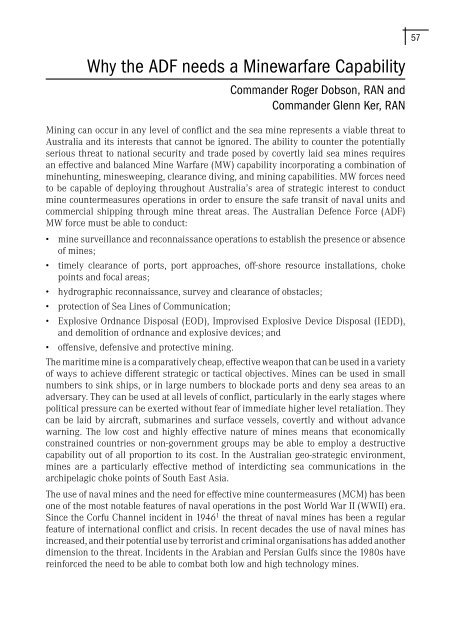Australian Maritime Issues 2005 - Royal Australian Navy
Australian Maritime Issues 2005 - Royal Australian Navy
Australian Maritime Issues 2005 - Royal Australian Navy
Create successful ePaper yourself
Turn your PDF publications into a flip-book with our unique Google optimized e-Paper software.
57<br />
Why the ADF needs a Minewarfare Capability<br />
Commander Roger Dobson, RAN and<br />
Commander Glenn Ker, RAN<br />
Mining can occur in any level of conflict and the sea mine represents a viable threat to<br />
Australia and its interests that cannot be ignored. The ability to counter the potentially<br />
serious threat to national security and trade posed by covertly laid sea mines requires<br />
an effective and balanced Mine Warfare (MW) capability incorporating a combination of<br />
minehunting, minesweeping, clearance diving, and mining capabilities. MW forces need<br />
to be capable of deploying throughout Australia’s area of strategic interest to conduct<br />
mine countermeasures operations in order to ensure the safe transit of naval units and<br />
commercial shipping through mine threat areas. The <strong>Australian</strong> Defence Force (ADF)<br />
MW force must be able to conduct:<br />
• mine surveillance and reconnaissance operations to establish the presence or absence<br />
of mines;<br />
• timely clearance of ports, port approaches, off-shore resource installations, choke<br />
points and focal areas;<br />
• hydrographic reconnaissance, survey and clearance of obstacles;<br />
• protection of Sea Lines of Communication;<br />
• Explosive Ordnance Disposal (EOD), Improvised Explosive Device Disposal (IEDD),<br />
and demolition of ordnance and explosive devices; and<br />
• offensive, defensive and protective mining.<br />
The maritime mine is a comparatively cheap, effective weapon that can be used in a variety<br />
of ways to achieve different strategic or tactical objectives. Mines can be used in small<br />
numbers to sink ships, or in large numbers to blockade ports and deny sea areas to an<br />
adversary. They can be used at all levels of conflict, particularly in the early stages where<br />
political pressure can be exerted without fear of immediate higher level retaliation. They<br />
can be laid by aircraft, submarines and surface vessels, covertly and without advance<br />
warning. The low cost and highly effective nature of mines means that economically<br />
constrained countries or non-government groups may be able to employ a destructive<br />
capability out of all proportion to its cost. In the <strong>Australian</strong> geo-strategic environment,<br />
mines are a particularly effective method of interdicting sea communications in the<br />
archipelagic choke points of South East Asia.<br />
The use of naval mines and the need for effective mine countermeasures (MCM) has been<br />
one of the most notable features of naval operations in the post World War II (WWII) era.<br />
Since the Corfu Channel incident in 1946 1 the threat of naval mines has been a regular<br />
feature of international conflict and crisis. In recent decades the use of naval mines has<br />
increased, and their potential use by terrorist and criminal organisations has added another<br />
dimension to the threat. Incidents in the Arabian and Persian Gulfs since the 1980s have<br />
reinforced the need to be able to combat both low and high technology mines.

















